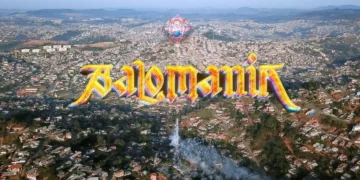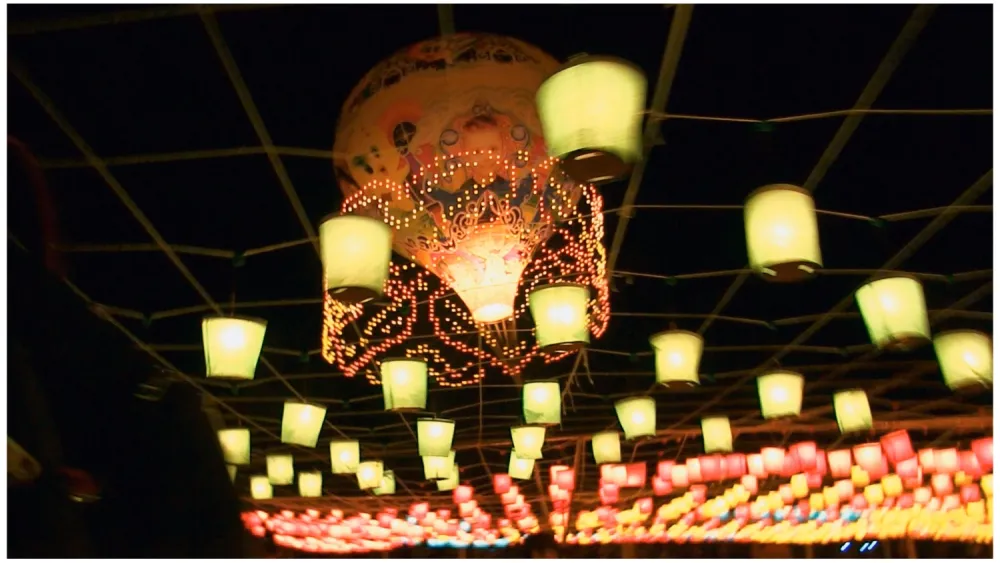Hidden away within the urban hillside communities of Brazil’s largest cities lies an unexpected creative culture. For years, underground crews of passionate artists have worked in secret to craft beautiful yet fleeting works of outdoor art. Their enormous hot air balloons, laboriously constructed and spectacularly launched overnight under cover of darkness, were a dramatic spectacle lighting up the night skies.
Yet these unauthorized aerial creations also made their makers targets as the local authorities sought to crack down on what they dismissed as mere criminal mischief or worse. It’s against this backdrop that a young filmmaker sought to shine a light on this hidden world and those daring souls who found meaning in their risky midnight missions.
Danish expatriate Sissel Morell Dargis was just a teenager when she first encountered Brazil’s underground balloon culture years ago. Fascinated by this community’s secret struggle to express themselves through their immense and illegal flying works of art, Dargis slowly gained the trust needed to document their craft over the better part of the last decade.
The result is her feature documentary debut Balomania, which pulls back the curtain on the incredible balloons and the people who dedicate themselves to their creation despite the serious legal risks they face. Through watching Dargis’ film, audiences are treated to a glimpse of a beautiful aspect of Brazilian culture that most will never get to experience firsthand high above the city streets.
Balloons Take Flight Underground
For generations, the residents of Brazil’s crowded hillside neighborhoods have come together each year to color the night skies with beautiful hot air balloons. While the tradition can be traced back to Catholic celebrations centuries ago, it truly blossomed in the 1980s as enthusiastic crews from different favelas began crafting ever more elaborate creations to launch amid competitive festivities. Soon entire communities would come out to watch in awe as towering origami wonders drifted overhead emblazoned with characters, landmarks, or messages of unity.
Yet this exuberant festival facing was facing growing pressures. As the bustling metropolises expanded, some saw the balloons as a potential safety hazard or nuisance. When new laws were passed in the late 90s banning unauthorized launches, it effectively drove the tradition underground. Undaunted, the balloon enthusiasts known as baloeiros continued their time-honored craft–now shrouded completely in secrecy as an illegal act. Working in isolated workshops and under cover of night, a new generation refined their art form alongside evasion tactics.
Now entire neighborhoods worked as stealth networks to protect their balloons. Launches involved split-second timing to get the delicate payloads airborne before the ever-vigilant police could crash their celebrations. Some groups specialized in chasing down any errant balloons to claim them before police confiscation, leading to pulse-pounding highway pursuits. The risks were great, with possible multi-year prison sentences for those caught partaking in the outlawed pastime.
Yet still the baloeiros toiled tirelessly. For them it was a profound act of community, expression, and defiance in the face of adversity. Their ephemeral art installations brightened not just the night sky but the spirits of all those who believed that even in the grimmest of places, a thing so beautiful could not possibly be wrong.
Capturing Trust Through Total Immersion
Filmmaker Sissel Dargis knew gaining the trust of Aloysio and the tight-knit baloeiros crews would take immense patience and commitment. For over a decade, the young Danish artist immersed herself in their secretive world through genuine participation in neighborhood festivals, late-night balloon launches, and the intricate labor of crafting each spectacular airborne work of art.
Only through such long-term cultural exchange and proving her respect for their traditions could Dargis hope to document the baloeiros’ vivid underground subculture with the fly-on-the-wall style it demanded. Shooting guerilla-style with just herself as camera operator, she blended seamlessly into the scene. Yet Dargis also understood that her presence as an participatory figure could lend the film richer emotional depth.
Gradually, the baloeiros came to view Dargis as one of their own, opening unseen corners of their lives for her lens. From the minutiae of balloon construction to high-speed pursuits fleeing authorities, her documentary brings a vivid sense of immersive participation. But Dargis also captures quiet moments of friendship and philosophy that provide cultural context in long late-night talks.
Balancing the disciplined realism of documentary with flourishes of cinematic artistry, Dargis is able to express the baloeiros’ profound passion for their ephemeral craft. From tattoos that seamlessly transition to drone footage, she infuses their story with poetry that celebrates humanity’s timeless desire to create and push boundaries, even in society’s shadows. Through a decade of careful relationship building and a filmmaker’s eye, Dargis gives us entry into a secret world.
Capturing Creativity Through Community
The baloeiro community portrayed in Balomania is far more complex than one might expect. Rather than a uniform group, Dargis shows us the diverse array of roles that have developed amongst its members. Some dedicate countless nights crafting balloons through meticulous silk-joining, while others relish the thrill of the chase once a creation takes flight. Beyond competitions between factions, the film reveals deep fraternal bonds that persist despite repressive laws.
Though the reasons remain vague, money from mystery sponsors facilitates the baloeiros’ astonishing efforts. However, it’s clearly not profit that drives them, but sheer passion for a fleeting art. By spending years manifesting vivid visions of figures and symbols massive enough to spot from the ground, they push creativity to its limits. And however briefly the skyscapes exist before flames or police disruption, those moments of collective witness seem to sustain the men through far darker periods.
Despite authorities dismissing their works as mere criminality, the balloons hold profound significance for a community existing at society’s margins. As egalitarian creations that illuminate favela neighborhoods from above, they symbolize a reclamation of space in a world otherwise beyond their control. Their evanescence also mirrors the transience of their lives on the streets, imbuing each launch with both beauty and tragedy.
Ultimately, Dargis presents the baloeiros not as a monolith but a collection of individuals for whom this risky tradition provides intense gratification and place. Even amid growing suppression, their fellowship endures through a shared determination to etch magnificence upon the canvas of the heavens, if only briefly, with each daring act of creation.
Capturing Counterculture through Creativity
One of Balomania’s most compelling aspects is how it meditates on themes of art and freedom through the baloeiros’ unique pursuits. Being deemed illegal, their hot air balloons exist in a controversial space – are they art, or public hazards? Dargis is evidently fascinated by this debate, seeing in the men’s multi-year creations an intensity many sanctioned artists lack.
The balloons’ temporary takeovers of the skies takes on symbolic weight as the baloeiros reclaim airspace above the favelas from which they typically feel excluded. Their expansive visions literally illuminate neighborhoods in fleeting moments of brilliance. That authorities dismiss such evanescent beauty indicates how threatened the establishment feels by displays which transcend boundaries.
Navigating a parallel underground operates as an act of resistance for the baloeiros, reflecting how social control likewise represses freethinking. That their works exist solely for personal fulfillment, outside market pressures, presents an unprecedented model which prioritizes passion over profit. Despite crackdowns, the community perseveres through fellowship and a shared commitment to improvised art outside mainstream indulgence.
Balomania thus illuminates how criminalizing counterculture serves to quell dissent, while the baloeiros’ undaunted devotion to glorious, high-risk creations represents resilience in the face of conformity. Their underground utopia, where sponsorship stems from solidarity rather than brands, stands as an inspiring triumph of expression over regulation and capitalism’s cold logic. The film enduringly captures this spirit.
Capturing a Close-Knit World through Cinematography
One hallmark of Balomania is its intimate, vérité style owing to Sissel as sole operator amid the secretive baloeiros. While footage often seems utilitarian, understandably rendered in haste, sporadic flourishes showcase artistry surpassing mere documentation.
A tattoo morphing into aerial footage exemplifies what few films achieve – imagery transcending recorded reality. Elsewhere, a story visually springs to chilling life through an indifferent television. These arresting passages stir curiosity about creatives ignored as criminal.
Gradually peeling back layers to earn subjects’ trust, Sissel affords an experience reflecting her own journey. Initial interactions convey skittish novelty amongst risk-taking social outliers. Later admitting crewmembers’ fondness, she clearly resonates with their passion.
Immersing viewers within the community as insiders nonetheless remains outside, Sissel locates humanity where authorities see only menace. Subtly, access deepens respect for kindred spirits pursuing beauty amid suppression. Technical limitations prove assets, transporting us to this world through sensibilities alone.
While mostly functional, Sissel’s handheld presentation absorbs us into baloeiros’ lived realities. Rare snippets of artistry intensify fascination with lives deemed transgressive yet thriving on fellowship and ephemeral triumphs. Hers is a special achievement, illuminating societal edges through shared compassion.
Capturing Humanity in Hidden Spaces
With Balomania, Sissel Morell Dargis undertook no small task. To record an underground community as secretive as the baloeiros demanded immense effort over many years. Yet her work proves invaluable for illuminating marginalized groups.
Dargis clearly bonded with her subjects. As trust developed, her portrayal conveyed baloeiros’ passion and fellowship and affirmed their artistic sparks. Beyond functional footage, fleeting flourishes display a deeper care for expressing their world.
Of course, questions remain. How do baloeiros finance lengthy projects with no material rewards? What impacts might intensifying policing bring? Dargis leaves such uncertainties unresolved, instead focusing on the relationships and releases that uplift participants, if only briefly.
More than elucidating an obscure practice, Balomania locates common hopes where few consider looking. It finds joy, compassion and creativity bursting forth where some perceive only danger. In quietly shining light on baloeiros’ hidden places, Dargis reminds us of humanity in society’s overlooked edges. Hers serves as an model of how determined, intimate documentation can uncover and celebrate shared spirit wherever it emerges.
The Review
Balomania
Balomania presents a captivating glimpse into an underground art world. Director Sissel Dargis deftly gains deep access to her secretive subjects through tireless, compassionate observation. While technical flaws reflect practical limitations, fleeting artistic passages strike profoundly. Above all, Dargis' documentary reminds us of shared joys that transcend surface divisions, affirming common humanity wherever it flowers.
PROS
- Intimate access to a secretive community
- Portrays subjects' passion and fellowship in a respectful light
- Features some aesthetically arresting cinematography
- Affirms humanity and creativity in marginalized places
CONS
- Technical limitations due to restrictions of clandestine filming
- Leaves uncertainties around sustainability unresolved
- Might lack mass appeal due to niche subject matter





















































